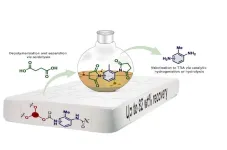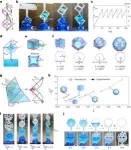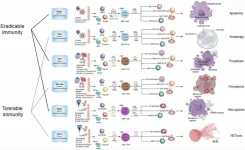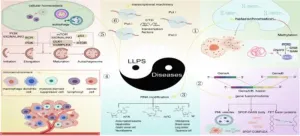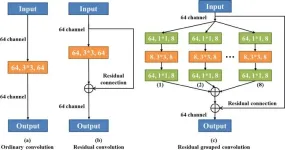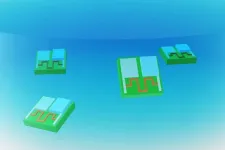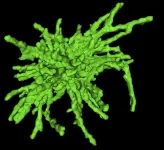(Press-News.org) Researchers discover smarter way to recycle polyurethane
Researchers at Aarhus University have found a better method to recycle polyurethane foam from items like mattresses. This is great news for the budding industry that aims to chemically recover the original components of the material – making their products cheaper and better.
Polyurethane (PUR) is an indispensable plastic material used in mattresses, insulation in refrigerators and buildings, shoes, cars, airplanes, wind turbine blades, cables, and much more. It could be called a wonder material if it weren’t also an environmental and climate burden. Most of the PUR products discarded worldwide end up being incinerated or dumped in landfills.
This is problematic because the main components of the material are primarily extracted from fossil oil. And we’re talking about significant quantities. In 2022, the global market for PUR reached almost 26 million tons, and a forecast for 2030 predicts nearly 31.3 million tons, with about 60% being foam in various forms.
However, there is a small but growing industry that chemically breaks down (depolymerizes) PUR into its original main components, polyol and isocyanate, with the aim of reusing them as raw materials in new PUR products.
Still, there is a long way to go before their output can actually compete with “virgin” materials. It is expensive to separate and purify the desired elements.
Breaking down and separating in one go
This is where a research team from Aarhus University comes in with a smart idea. They base their method on what the companies in question already use, namely breaking down PUR foam with acid (acidolysis).
But the companies do not separate the broken-down PUR into polyol and isocyanate. This results in a mixture that cannot be directly recycled but requires their customers to use new recipes.
The AU researchers are not only able to break down PUR and separate the two main components – they can do it in one go. They heat flexible PUR foam to 220°C in a reactor with a bit of succinic acid (see fact box). Afterwards, they use a filter that catches one material and lets the other pass through.
It is the polyols that pass through, and they do so in a quality comparable to virgin polyol, making it possible to use them in new production of polyurethane. The solid part of the product mixture that is filtered out is transformed into a so-called diamine in a simple hydrolysis process, which is used in the production of isocyanates and thus PUR.
In this way, the researchers are able to recover up to 82 weight percent of the original material from flexible PUR foam – used in mattresses – as two separate fractions of diamines and polyols. The researchers have recently published their findings in the scientific journal Green Chemistry.
Enormous potential in the industry
"The method is easy to scale up," points out one of the study’s authors, Steffan Kvist Kristensen, assistant professor at the Interdisciplinary Nanoscience Center (iNANO) at Aarhus University.
He sees enormous potential for recycling the PUR foam waste at the factories that use it as raw material (slabstock) in their production.
"But the prospect of also handling PUR waste from consumers requires further development," he adds.
... but still a long way to go to a circular economy
Manufacturers in the PUR industry each use unique formulae to achieve specific material properties for their products.
Therefore, a number of challenges need to be solved before a real economy in recycling polyurethane can be achieved:
- Waste sorting
- Logistics
- Sorting PUR into types
Depolymerization is thus only a small part of the solution.
Not just soft foam
AU researchers have also tested the combination of acidolysis and hydrolysis on regenerated PUR foam and rigid PUR foam. And it works.
But the paths to a circular economy are even longer here.
Rigid PUR foam is primarily used as insulation materials, but the endeavour to transform it into valuable raw materials is still in its infancy.
Right now, the researchers are testing the new technology on other polyurethane materials to see how these can be recycled. They are also investigating how the dicarboxylic acid, which is part of the process, can be reused. Additionally, they will test the recycled materials to create new products to show that the technology can truly create a circular economy.
FACTS:
Polyurethane is typically created in a chemical reaction between the main components polyol and isocyanate, which are mostly derived from fossil oil. Polyurethane is a polymer (a long chain of molecules), so when talking about chemically breaking down polyurethane, it is called depolymerization.
Succinic acid is a natural acid, an antioxidant that plays an important role in the body's energy production. It is used both as a food additive and as a starting material for several types of plastics. In this case, succinic acid can break down polyurethane (PUR) without the use of other chemicals.
END
Researchers discover smarter way to recycle polyurethane
Researchers at Aarhus University have found a better method to recycle polyurethane foam. This is great news for the budding industry that aims to chemically recover the original components of the material – making their products cheaper and better.
2024-08-16
ELSE PRESS RELEASES FROM THIS DATE:
Right on schedule: Physicists use modeling to forecast a black hole's feeding patterns with precision
2024-08-16
Powerful telescopes like NASA’s Hubble, James Webb, and Chandra X-ray Observatory provide scientists a window into deep space to probe the physics of black holes. While one might wonder how you can “see” a black hole, which famously absorbs all light, this is made possible by tidal disruption events (TDEs) - where a star is destroyed by a supermassive black hole and can fuel a “luminous accretion flare.” With luminosities thousands of billions of times brighter than the Sun, accretion events enable astrophysicists to study supermassive black holes (SMBHs) at cosmological distances.
TDEs occur when a star is violently ripped ...
Cell death types and their relations to host immune pathways
2024-08-16
“We have proposed a framework encompassing all discovered host immunological pathways, such as TH1, TH2a, TH2b, TH3, TH9, TH17, TH22, TH1-like, and THαβ immune reactions”
BUFFALO, NY- August 16, 2024 – A new review was published as the cover paper of Aging (listed by MEDLINE/PubMed as "Aging (Albany NY)" and "Aging-US" by Web of Science), Volume 16, Issue 15, entitled, “Types of cell death and their relations to host immunological pathways”.
Various ...
Perceived parental distraction by technology and mental health among emerging adolescents
2024-08-16
About The Study: In a cohort study of 1,300 emerging adolescents ages 9 to 11 across three assessments, higher levels of anxiety symptoms were associated with higher levels of perceived parental technoference later in development. Higher levels of perceived parental technoference were associated with higher levels of inattention and hyperactivity symptoms later in development. The findings of this study speak to the need to discuss digital technology use and mental health with parents and emerging adolescents as a part of routine care.
Corresponding Author: To contact ...
Liquid-liquid phase separation in diseases
2024-08-16
This paper, led by Professor Wu (Wenzhou Institute University, Wenzhou Medical University) and Professor Huang (Northeastern University), explores LLPS, a phenomenon closely associated with various diseases, including cancer and neurodegenerative disorders. As a frontier research area, LLPS plays a significant role in cancer through its regulation of multiple facets, including signaling pathways, gene expression, and tumor microenvironment. Dysregulation of LLPS leads to the formation of various aggregates, such as amyloid proteins, suggesting that modulating LLPS in ...
Advanced U-net segmentation model using residual grouped convolution and attention mechanism for brain tumor MRI image segmentation
2024-08-16
The brain is responsible for the "general command" of human thinking and coordination of the body. Thus, various brain diseases can cause great damage to the human body and nervous system. Brain tumors are caused by abnormal cells that grow and multiply irregularly within the brain. Glioma is one of the most common malignant tumors in adults. It originates from glial cells and the surrounding infiltrating tissue, compresses other normal tissues in the brain during the growth process, and blurs the boundary of the tumor. ...
PolyU develops versatile fluidic platform for programmable liquid processing
2024-08-16
Society relies heavily on diverse fluidic technologies. The ability toprecisely capture and release various chemical and biological fluids plays a fundamental role in many fields.A long-standing challenge is to design a platform that enables the switchable capture and release of liquids with precise spatial and temporal control and accurate volumes of the fluid. Recently, researchers at The Polytechnic University of Hong Kong (PolyU) have invented a new method to effectively overcome this challenge.
Led by Prof. WANG Liqiu, Otto Poon Charitable Foundation Professor in Smart and Sustainable Energy, Chair ...
MIT engineers design tiny batteries for powering cell-sized robots
2024-08-16
A tiny battery designed by MIT engineers could enable the deployment of cell-sized, autonomous robots for drug delivery within in the human body, as well as other applications such as locating leaks in gas pipelines.
The new battery, which is 0.1 millimeters long and 0.002 millimeters thick — roughly the thickness of a human hair — can capture oxygen from air and use it to oxidize zinc, creating a current of up to 1 volt. That is enough to power a small circuit, sensor, or actuator, the researchers showed.
“We think this is going to be very enabling ...
New tool simplifies cell tracking data analysis
2024-08-16
Studying cell migration is vital because it plays a crucial role in many biological processes, including immune response, wound healing, and cancer metastasis. Understanding how cells move and behave can lead to breakthroughs in treating diseases, developing new drugs, and creating innovative therapies. For example, in cancer research, tracking how cancer cells migrate can reveal how tumors grow and spread through the human body. This insight can led to the discovery of more efficient and targeted treatments to stop or even prevent metastasis.
Scientists have introduced CellTracksColab, a tool that simplifies cell tracking data analysis. This free platform leverages advanced ...
Exploring Huntington’s disease, researchers discover that protein aggregates poke holes in nuclear membrane
2024-08-16
Researchers at Utrecht University in the Netherlands have identified a new way in which the toxic protein aggregates associated with Huntington’s disease may damage nerve cells and cause them to die. The study, to be published August 16 in the Journal of Cell Biology (JCB), suggests that the aggregates can poke holes in the membrane that separates the nucleus from the rest of the cell, damaging the DNA inside the nucleus and changing the activity of neuronal genes.
Huntington’s disease is a devastating neurogenerative disorder caused by a mutation in the HTT gene that results in cells producing abnormally large versions of the huntingtin protein. These ...
Why isn't Colorado's snowpack ending up in the Colorado River? New research suggests the problem might be the lack of spring rainfall
2024-08-16
The Colorado River and its tributaries provide water for hydropower, irrigation and drinking water in seven U.S. states and Mexico. Much of this water comes from the snowpack that builds up over the winter and then melts each spring. Every year in early April, water managers use the snowpack to predict how much water will be available for the upcoming year.
But since 2000, these predictions have been incorrect, with the actual streamflow being consistently lower than the predicted streamflow. That’s left water managers ...
LAST 30 PRESS RELEASES:
Injectable breast ‘implant’ offers alternative to traditional surgeries
Neuroscientists devise formulas to measure multilingualism
New prostate cancer trial seeks to reduce toxicity without sacrificing efficacy
Geometry shapes life
A CRISPR screen reveals many previously unrecognized genes required for brain development and a new neurodevelopmental disorder
Hot flush treatment has anti-breast cancer activity, study finds
Securing AI systems against growing cybersecurity threats
Longest observation of an active solar region
Why nail-biting, procrastination and other self-sabotaging behaviors are rooted in survival instincts
Regional variations in mechanical properties of porcine leptomeninges
Artificial empathy in therapy and healthcare: advancements in interpersonal interaction technologies
Why some brains switch gears more efficiently than others
UVA’s Jundong Li wins ICDM’S 2025 Tao Li Award for data mining, machine learning
UVA’s low-power, high-performance computer power player Mircea Stan earns National Academy of Inventors fellowship
Not playing by the rules: USU researcher explores filamentous algae dynamics in rivers
Do our body clocks influence our risk of dementia?
Anthropologists offer new evidence of bipedalism in long-debated fossil discovery
Safer receipt paper from wood
Dosage-sensitive genes suggest no whole-genome duplications in ancestral angiosperm
First ancient human herpesvirus genomes document their deep history with humans
Why Some Bacteria Survive Antibiotics and How to Stop Them - New study reveals that bacteria can survive antibiotic treatment through two fundamentally different “shutdown modes”
UCLA study links scar healing to dangerous placenta condition
CHANGE-seq-BE finds off-target changes in the genome from base editors
The Journal of Nuclear Medicine Ahead-of-Print Tip Sheet: January 2, 2026
Delayed or absent first dose of measles, mumps, and rubella vaccination
Trends in US preterm birth rates by household income and race and ethnicity
Study identifies potential biomarker linked to progression and brain inflammation in multiple sclerosis
Many mothers in Norway do not show up for postnatal check-ups
Researchers want to find out why quick clay is so unstable
Superradiant spins show teamwork at the quantum scale
[Press-News.org] Researchers discover smarter way to recycle polyurethaneResearchers at Aarhus University have found a better method to recycle polyurethane foam. This is great news for the budding industry that aims to chemically recover the original components of the material – making their products cheaper and better.
